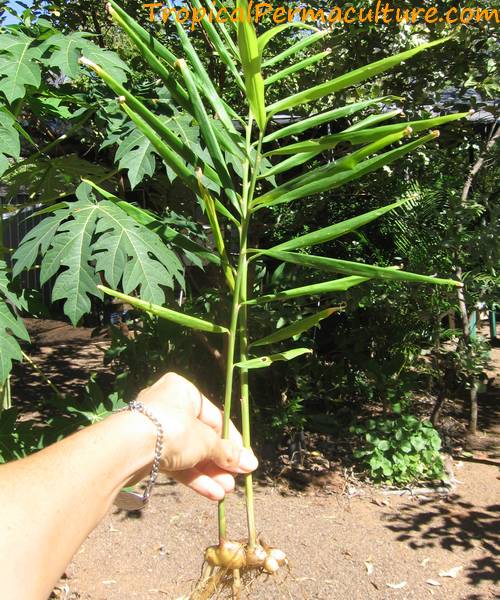Growing Sweet Potatoes
(Impomoea Batatas)
How To Grow Sweet Potato Vines At Home
Growing Sweet Potatoes is very easy in tropical and sub tropical climates.
(And not difficult in cool climates, either.)
In fact, the question is not how to grow sweet potatoes, it's rather how to stop sweet potato vines from taking over the whole garden! Sweet potato is a very invasive creeper...
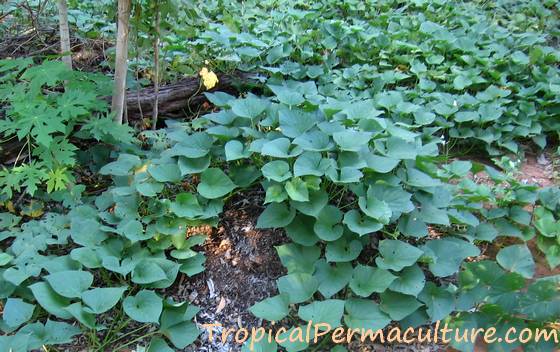
But even though they can be a pain in the you know what if not managed (harvested regularly), you absolutely have to grow sweet potatoes! Why?
Sweet potato is one of the most useful food plants in a warm climate:
- Sweet potatoes are the perfect substitute for normal potatoes.
- Sweet potatoes have less disease problems.
- Growing sweet potato vines is much easier than growing other potatoes.
- Sweet potatoes are very nutritious.
- And sweet potatoes grow with little water and fertilizer.
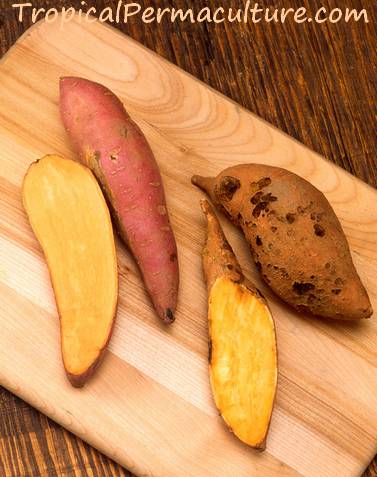
You can use sweet potatoes in the kitchen just like you would use potatoes. Boil them, steam them, mash them, fry them... But sweet potatoes have more uses:
- You can eat young sweet potato shoots and leaves in stir fries and salads.
- Sweet potatoes also make a wonderful quick growing ground cover.
- You can use them as a living mulch and to keep weeds down.
So, how do you grow sweet potatoes, and how do you keep them under control?
How To Grow Sweet Potatoes
Sweet potato plants are fast growing vines that cover the ground.
Originally they come from Central and South America, which means they are a warm weather vegetable. You need a long warm season to grow good sweet potatoes.
There are sweet potato varieties with red, yellow and white tubers. The red ones have the highest carotenoid content and have become the most popular variety. But all sweet potatoes are very nutritious in general, especially if you use the leaves and shoots, too.
You'll be hard pressed to find a plant that produces more nutrition per square metre than the humble sweet potato!
What Sweet Potatoes Like And Dislike
Sweet potatoes like growing in sandy soils, lots of sun, lots of space, and a reasonable amount of water and nutrients. They love heat. The hotter it is the faster they grow.
Sweet potatoes don't like heavy, waterlogged soils, cold weather, and fertilizers high in nitrogen (like chicken manure, it makes them grow lots of leaves but no potatoes).
Propagating Sweet Potatoes
The quickest and easiest way to grow sweet potatoes is to use cuttings. Simply cut a piece of a runner, about a foot (30 cm) in length.
Remove all the leaves except for the tiny leaves at the very tip. Plant the cutting by covering the whole length with soil, only the leaves of the tip should stick out of the ground.
The cuttings will root at every leave node. Not just the leave nodes under the ground will root. A sweet potato also grows roots from every leave node that develops as your cutting grows.

If you can't get hold of cuttings you can start growing sweet potatoes by planting the tubers. You can use any shop bought sweet potatoes.
Place them on the ground, cover them with soil, and keep them moist. The tubers will develop shoots, called slips.
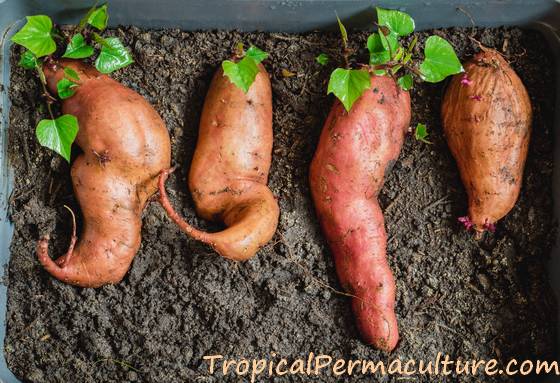
Slips can be snipped or pulled off and planted out when they are about 15 cm in size. The original root will continue to produce more slips.
Growing Sweet Potatoes In Water
It's a popular project in school classes: growing sweet potato vines in a glass of water. You can do that by putting a tuber into water, pointy end down, with the top third above the water. Slips will grow from the eyes of the tuber.
You can plant those shoots out just like the slips grown in soil.
Some people root the slips in water as well. It's nice to watch for children but it has no benefit whatsoever. Rooting any plant in a glass of water does not make sense other than for demonstration and teaching purposes.
Planting Sweet Potatoes
The best soil for sweet potatoes is sandy but they can grow in all soils. If you have heavy soil plant sweet potatoes on mounds or ridges.
Raising the beds improves the drainage (very important) and gives the tubers a nice deep soil to develop in. (Otherwise you may end up with small, bent and forked sweet potatoes.)
The soil should have a good supply of nutrients, for example from digging in mature compost. Do not use fresh manures or any fertilizers high in nitrogen (like pelleted chicken manure). You'd just end up with lots of leaves and no tubers.
Growing sweet potatoes requires some space, so plant them where they can spread. Space your cuttings or slips about a foot apart in a row, and leave three to four feet between rows. (If you plant in rows, that is.)
Mulch thickly between plants and even between the beds to initially keep the weeds down. Once the sweet potatoes grow they will choke all weeds down themselves.
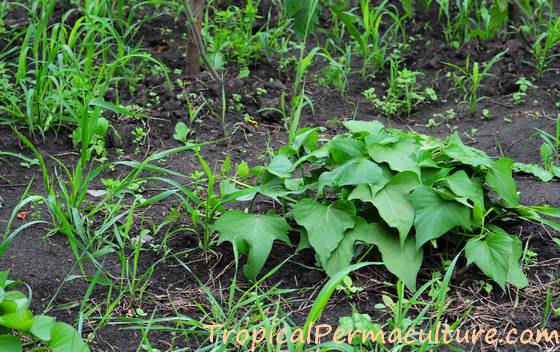
For planting time the general recommendation is to plant a patch in spring. (May in the northern hemisphere, November in the southern). In a cool climate you may indeed have to get by with a single planting. Sweet potatoes do need four to six months of reasonably warm weather to mature.
But in the tropics one big spring planting does not make sense, unless you are a commercial grower.
Sweet potatoes don't keep well after harvest, so the best way is to plant a few cuttings every week or two. Just one row of one metre length, with three cuttings. They will take about 16 to 18 weeks to mature in warm weather, longer in cooler weather.
That way you can grow sweet potatoes all year round, and you don't find yourself with a big pile of them all at once.
Growing Sweet Potatoes The Lazy Way
If you have enough room you can also plant a permanent sweet potato patch. I did.
When I started growing sweet potatoes I didn't plant in rows. I have plenty of space, so I planted some sweet potatoes as a ground cover under most of my fruit trees.
They did extremely well, and now my whole orchard is covered in sweet potatoes. They don't need any care, and when I want some sweet potatoes I can usually find a few there. I just look for a thickened stem, or walk around feeling for a lump, and start digging. It's too easy.
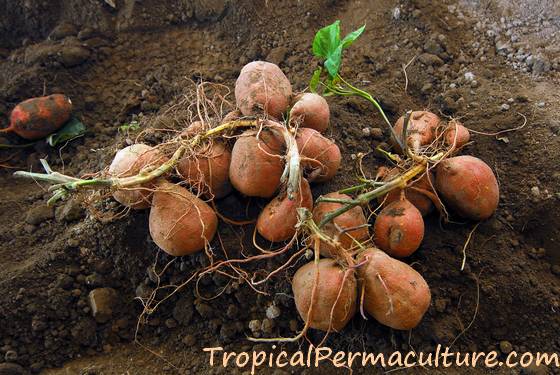
How Much Water? How Much Plant Food?
Although sweet potatoes are a very tropical vegetable they can get by with little water once established. However, the freshly planted cuttings need to be watered regularly.
Make sure plants don't become waterlooged. If your soil isn't free draining it's safest to grow sweet potatoes on mounds.
If you think the quality of your soil is not good enough fertilize your plants at planting time, at six weeks of age, and maybe once more at twelve weeks. Or whenever you remember to do it...
Just make sure you use a balanced fertilizer, for example seaweed extract. A sprinkle of sulfate of potash also doesn't go astray. Compost that had lots of wood ash in it is even better. Avoid high nitrogen fertilizers. Root crops like potassium and phosphorus, not nitrogen.
Harvesting Sweet Potatoes
After four to six months, depending on the temperatures, your sweet potatoes will be ready. You will see that the original stem of your cutting or slip will have thickened, and when you carefully lift the plant with a fork you should find two or three sweet potatoes at the base.
You can harvest sweet potato leaves and young shoots at any time, it does not affect the plant or tubers.
Problems When Growing Sweet Potatoes
In the tropics sweet potatoes have one serious pest, and that's the sweet potato weevil. An adult weevil is a metallic blue and orange and about 6 mm long. It eats everything, stems, leaves and roots. The weevils lay their eggs in the roots and the larvae tunnel through the roots and make a rotten mess of them.
If you have problems with sweet potato weevils you can't grow a permanent sweet potato patch. Just use the other sweet potato growing method.
Plant slips or cuttings, that way you don't transfer any weevils. Dig up the whole crop, don't leave any tubers in the ground, and start afresh with cuttings in a different bed. That way weevils will never be a problem again.


